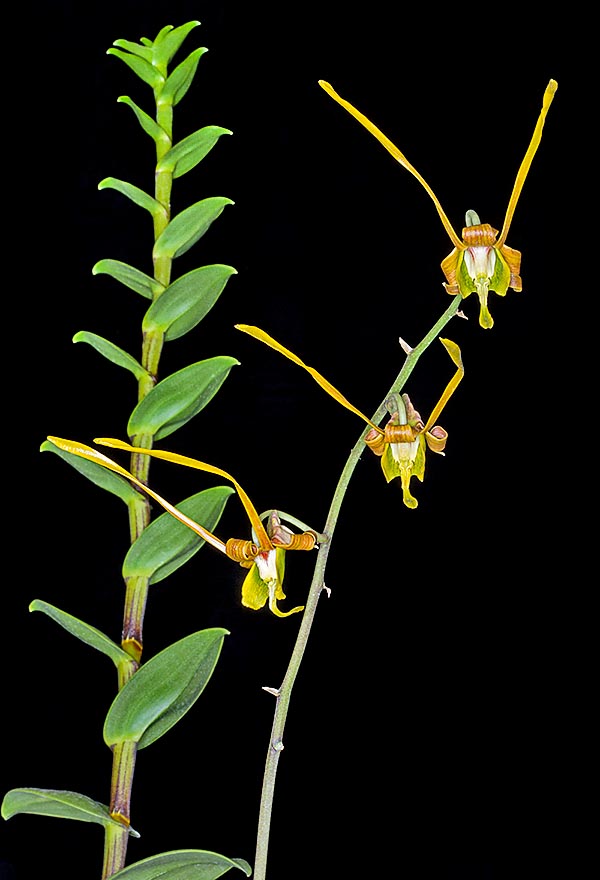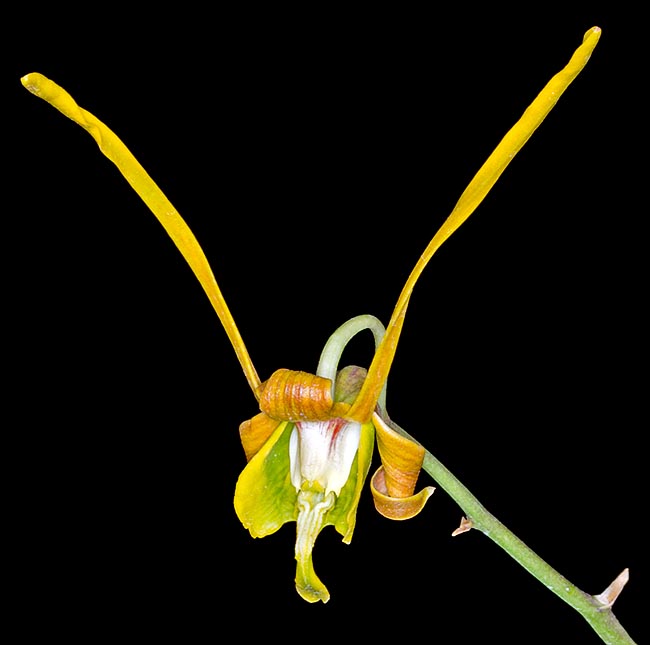Family : Orchidaceae

Text © Pietro Puccio

English translation by Mario Beltramini

Dendrobium sutiknoi is an unusual epiphyte of New Guinea described only in 2005 © Giuseppe Mazza
The name of the genus is the combination of the Greek substantives “δένδρον” (dendron) = tree and “βίος” (bios) = life, with reference to the numerous species of the genus living on the trees.
The species is honoured to the Indonesian agriculturist and collector Sutikno, who has introduced it in cultivation.
Common names: Sutikno’s dendrobium (English).
The Dendrobium sutiknoi P.O’Byrne (2005) is an epiphytic species with thin cylindrical pseudobulbs, 0,5-1,5 m long, provided for almost all their length of alternate, distichous, ovate-elliptic with pointed apex, coriaceous, intense green leaves.
Racemose inflorescences from the upper nodes carrying 5-15 flowers, about 8 cm long and 3,5 cm broad.
Linear twisted greenish brown or yellowish brown sepals, the lateral ones, merged at the base of the column, form a sort of a conical spur (mentum).
Linear petals with pointed apex, erect and twisted, greenish brown, trilobed labellum with yellowish green lateral lobes with yellow margin and spatulate central lobe, about 1,5 cm long, thin, retroflexed, and finally column of cream colour with two small sharp teeth on the sides of the apex.
It reproduces by seed, in vitro, and division, to be done by the vegetative restart, with each section provided of at least 3-4 pseudobulbs.
Recently described species and still rare in cultivation, it distinguishes due to the attractive long lasting flowers, 7-9 weeks, the particularly long erect petals and the labellum with thin median lobe; requires high luminosity, also some hours of direct sun light, averagely high temperatures, 24-32 °C, during the whole year, with lowest night values not under the 16-18 °C during the vegetative stasis, high humidity, 70-85%, and constant movement of the air.

The cylindrical and thin pseudobulbs can be one metre and a half long. The inflorescences carry even 15 flowers about 8 cm long and 3,5 cm broad lasting 7-9 weeks, but is still very rare in cultivation © Giuseppe Mazza
The waterings and the nebulisations are to be done with rainwater, from reverse osmosis or demineralised.
For the fertilizations, duly distributed and alternated, in way to avoid salts accumulation at the roots, to be done exclusively during the vegetative period, are to be used preferably hydrosoluble balanced products, with microelements, at ½ - ¼ of the dosage shown on the package.
It can be mounted on bark, trunks, rafts of cork or of arborescent ferns roots, or cultivated in pots or baskets with particularly draining and aerated compost, to allow the roots to quickly dry up after each watering, that may be formed by medium sliced bark and charcoal fragments with possible addition of polystyrene or earthenware, for improving the drainage; the repottings are to be done, when necessary, by the vegetative restart, signalled by the appearance of the new roots.
The species is reported in the appendix II of the CITES (species whose trade is internationally ruled).
→ For general notions about ORCHIDACEAE please click here.
